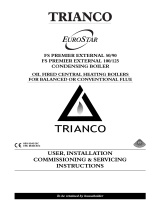
Page 6
TEST SWITCH
A test switch is tted to the control panel (see Figure 1-1) to
allow the Service Engineer to test-re the boiler without requiring
access to the inside of the property.
It does this by overriding the heating system controls (see Section
2.6) for a short period of time, before automatically switching o
and allowing the boiler to be controlled by the heating system
controls again.
! NOTE !
The mains power supply still needs to be switched on for
the test switch to work.
2.6 HEATING SYSTEM CONTROLS
PROGRAMMER (IF FITTED)
If a programmer is tted, it will control the times that the boiler
heats the central heating system and hot water cylinder (if tted).
Refer to the manufacturer’s instructions supplied with your
programmer for further details.
ROOM THERMOSTAT
This thermostat allows you to control the room temperature at
which the boiler will re to provide central heating to your property.
The room thermostat is usually located in a downstairs area such
as a hallway or living area.
If your heating system is ‘zoned’ you will have more than one
room thermostat, with each thermostat controlling the temperature
of a separate heating zone.
! NOTE !
For your boiler to operate to provide you with heating,
the programmer (or timer) must be in an ‘ON’ period for
heating AND the room thermostat must be ‘calling’ for heat.
CYLINDER THERMOSTAT
This thermostat controls the temperature of the water in your hot
water cylinder (if tted), as long as your cylinder is being heated
by the boiler.
When the water temperature in the cylinder is below the
thermostat set temperature, it will ‘call’ for the boiler to operate to
heat your hot water.
! NOTE !
For your boiler to operate to provide heat to your hot water
cylinder, the programmer (or timer) must be in an ‘ON’
period for hot water AND the cylinder thermostat must be
‘calling’ for heat.
THERMOSTATIC RADIATOR VALVES
Your heating system may also include Thermostatic Radiator
Valves (or TRVs). If you have them, they will be tted on some or
all of your heating system radiators.
A TRV is a self-regulating valve, i.e. not connected to the
other heating system controls, such as a programmer or room
thermostat, and is designed to regulate the temperature in the
room in which it is situated.
A TRV senses the air temperature around it and controls the
water ow to the radiator on which it is tted to regulate its heat
output to the room. The head of the TRV can be rotated to set it to
give the required room temperature. Once correctly set, it should
ideally be left in that position and not used as an on/o control for
the radiator.
As the correct operation of a TRV is based on it sensing the air
temperature of the room it is tted in, take care not to cover the
TRV head (with curtains, furniture etc).
Refer to the manufacturer’s instructions supplied with any TRVs
tted to your heating system for further details.
3 CARING FOR YOUR
BOILER
3.1 CHECKING SEALED SYSTEM
PRESSURE
If your boiler is operating on a sealed system, your installer will
have pressurised the system and should have told you (or set
it on the pressure gauge*) the system pressure when cold. This
pressure is normally between 0.5 and 1.0 bar, which will increase
slightly when the system is hot.
*Your installer should have shown you where the system pressure
gauge is located.
Figure 3-1: Pressure gauge during normal boiler operation
You should frequently check that the system pressure is correct.
If the pressure (when the heating system is cold) is below the set
pressure mentioned above, you can re-pressurise the system by
following the instructions given in Section 3.2.
If the system requires re-pressurising frequently, ask your installer
or service engineer to check the heating system for leaks and to
check the expansion vessel air charge.
AIR VENTS
The boiler and/or system will be tted with an air vent to remove
air from the system.
Any air trapped in the radiators should be removed by venting the
radiators using the vent screw at the top of each radiator. Only
vent a radiator if the top is cool and the bottom is hot. Excessive
venting will reduce the system pressure, so only vent when
necessary and check the system pressure as mentioned above.
Re-pressurise the system if necessary.
PRESSURE RELIEF (SAFETY) VALVE
The sealed system will be tted with a safety valve to release
excess pressure from the system. If water or steam is emitted
from the safety valve discharge pipe, switch o the boiler and
contact your installer or service engineer immediately.
If a Grant Vortex External Sealed System Kit is tted, this safety
valve will be located inside the boiler casing.
Section 2: Using your Boiler & Section 3: Caring for your Boiler
2.7 ELECTRICITY SUPPLY
The boiler requires a 230/240 V AC 50 Hz supply. It must be
protected by a 5 Amp fuse.
! WARNING !
The electrical connections to the boiler must be earthed.
0
1
2
3
4
Normal Operating
Pressure** Range
**This is the
pressure inside
the heating
system while the
system is hot.















